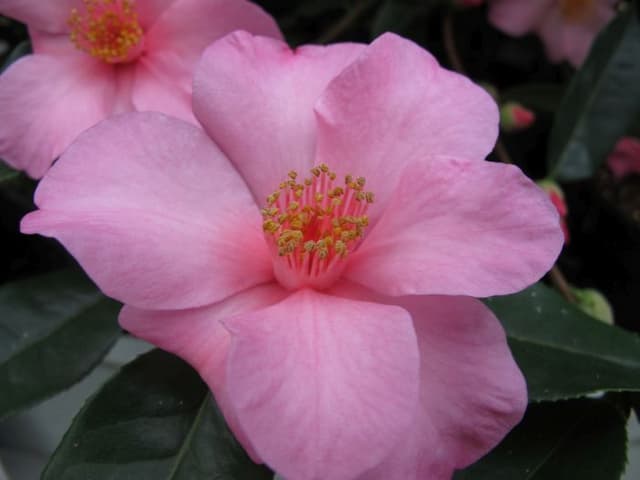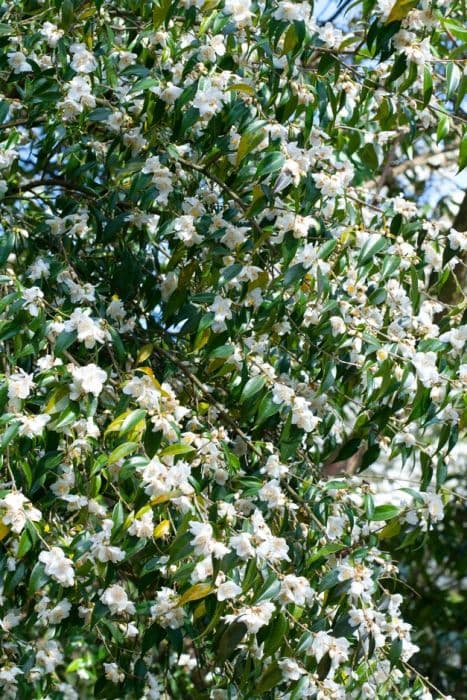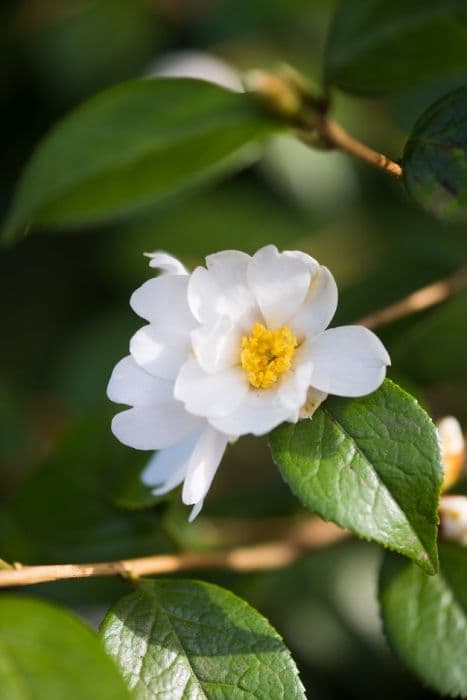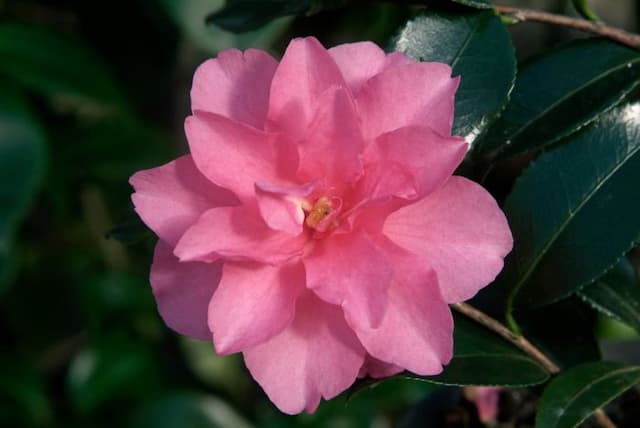Taiwan Camellia Camellia transnokoensis

ABOUT
Camellia transnokoensis, commonly known as the Taiwan mountain camellia, is a captivating plant notable for its aesthetic appeal. This species boasts glossy, deep green leaves that provide a lush backdrop to its striking blooms. The leaves are typically oval-shaped with a slightly pointed tip, creating an elegant foliage presentation. The true showstoppers, however, are the flowers that emerge on this plant. They are typically white, though some may carry a hint of pink, casting a delicate and sophisticated vibe. Each bloom is comprised of multiple layers of petals that unfurl in a symmetrical fashion, reminiscent of classic camellia forms. The blossoms are known for their beauty and often attract enthusiasts with their charm. In the center of these blooms, contrasting golden yellow stamens often nestle, providing a vibrant focal point and enhancing the overall allure of the plant. This burst of color amid the white petals contributes to a visually stunning contrast. Taiwan mountain camellia's blooming season adds to the spectacle, as the plant dons its floral attire, becoming a beacon of natural elegance. The flowers not only contribute to the visual splendor but also might attract pollinators to the garden, adding dynamism to the plant's surroundings. Despite its ornate features, the Taiwan mountain camellia maintains a form that is pleasing and not overwhelming, as its charm lies in its details rather than its stature. The overall appearance of this plant is one of refined beauty, making it a prized specimen in gardens where its floriferous display can be fully appreciated.
About this plant
 Names
NamesSynonyms
Transnokoensis Camellia, Taiwan Mountain Camellia, Yu Shan Cha.
Common names
Camellia transnokoensis.
 Toxicity
ToxicityTo humans
Camellia transnokoensis, also known simply as camellia, is not commonly known to be toxic to humans. Most camellia species, including Camellia transnokoensis, are considered non-toxic, and there are no widespread reports of poisoning from ingesting parts of this plant. Therefore, consuming this plant should not cause any symptoms of poisoning. However, it is always advisable to exercise caution and avoid eating plants if their edibility is uncertain or if one is not knowledgeable about them.
To pets
Camellia transnokoensis, commonly referred to as camellia, is generally not considered toxic to pets. There are no significant reports of toxicity in animals such as cats and dogs from ingesting this plant. The camellia has a long history of cultivation and no part of it is known to cause adverse symptoms if pets happen to ingest it. However, it is always a good practice to keep an eye on pets and prevent them from eating plants, as individual animals might have varying sensitivities or allergies to non-toxic plants.
 Characteristics
CharacteristicsLife cycle
Perennials
Foliage type
Evergreen
Color of leaves
Green
Flower color
White
Height
6-10 feet (1.8-3 meters)
Spread
5-7 feet (1.5-2.1 meters)
Plant type
Shrub
Hardiness zones
7
Native area
Taiwan
Benefits
 General Benefits
General Benefits- Ornamental Value: Camellia transnokoensis, commonly known as the Taiwan Camellia, is often used for decorative purposes due to its attractive flowers and glossy evergreen foliage.
- Landscape Diversity: The Taiwan Camellia contributes to the biodiversity of gardens and parks, providing habitat and food for a variety of insects and birds.
- Erosion Control: The plant's root system can help stabilize soil and prevent erosion, especially in sloped areas of a garden or natural landscape.
- Shade Provider: As a shrub or small tree, it can provide shade for smaller plants and contribute to the creation of microclimates within a garden setting.
- Seasonal Interest: The Taiwan Camellia blooms in late winter to early spring, adding color and interest to gardens during a season when few other plants are in flower.
 Medical Properties
Medical PropertiesThis plant is not used for medical purposes.
 Air-purifying Qualities
Air-purifying QualitiesThis plant is not specifically known for air purifying qualities.
 Other Uses
Other Uses- Artistic Inspiration: The vibrant blooms and elegant foliage of Camellia transnokoensis can serve as a muse for artists and photographers, capturing its beauty through various mediums.
- Culinary Garnish: The flowers of Camellia transnokoensis can be used as an edible decoration to add a touch of elegance to gourmet dishes.
- Dye Production: The petals of this plant can be used to create natural dyes for fabrics or art materials, providing a source of subtle color.
- Aromatherapy: The subtle fragrance of Camellia transnokoensis can be infused in oils and used for relaxation and stress relief in aromatherapy practices.
- Perfumery: The delicate scent extracted from the blooms of Camellia transnokoensis can be used in crafting personal perfumes or scented products.
- Wedding Decor: Its flowers and leaves can be incorporated into bridal bouquets, centerpieces, and venue decorations for their natural beauty and sophistication.
- Educational Tool: Camellia transnokoensis can be used in schools or educational programs to teach students about botany and the lifecycle of plants.
- Bonsai Cultivation: Enthusiasts might use the Camellia transnokoensis for bonsai due to its attractive flowers and growth habit, cultivating it in miniature form.
- Cultural Symbolism: The plant can represent refinement and perfection in various cultures, making it an ideal gift for special occasions to convey a meaningful message.
- Biodegradable Confetti: Dried petals of Camellia transnokoensis can be used as eco-friendly confetti for celebrations and events, decomposing naturally after use.
Interesting Facts
 Feng Shui
Feng ShuiThe plant Camellia is not used in Feng Shui practice.
 Zodiac Sign Compitability
Zodiac Sign CompitabilityThe plant Camellia is not used in astrology practice.
 Plant Symbolism
Plant Symbolism- Love and Affection: As with many camellias, Camellia transnokoensis (commonly known as the Taiwan mountain camellia) often symbolizes love, affection, and admiration. It is a common gift between lovers and signifies deep emotional bonds.
- Beauty: The elegant flowers of the Taiwan mountain camellia represent beauty and perfection, making them a popular choice in floral arrangements for special occasions that celebrate these qualities.
- Longevity: Many cultures associate camellias with longevity and endurance, due to the plant's hardiness and the long-lasting nature of its blooms.
- Devotion: The Taiwan mountain camellia's enduring qualities are also seen as a symbol of devotion and faithfulness in a relationship, representing the steadfastness of true love.
 Water
WaterThe Taiwan Camellia should be watered thoroughly, allowing the top inch of soil to dry out between watering sessions. This typically means watering once or twice a week, but this can vary depending on climate and season. It's best to use about 1 gallon of water for each watering session for a medium-sized plant, ensuring even saturation of the soil. During the growing season in spring and summer, water needs may increase, while in the cooler fall and winter months, they may decrease. Avoid letting the plant sit in water as this can lead to root rot.
 Light
LightTaiwan Camellias thrive in partial shade to dappled sunlight. They should be placed in a spot that receives morning light but is shielded from the intense afternoon sun. A location under a canopy of trees that allows filtered sunlight is ideal, as it mimics their natural growing conditions.
 Temperature
TemperatureTaiwan Camellias prefer a temperature range between 60°F and 80°F. They can survive minimum temperatures down to around 20°F but should not be exposed to such cold for prolonged periods. Ideally, they should be protected from temperature extremes, avoiding locations where temperatures might drop below freezing or rise above 90°F.
 Pruning
PruningTaiwan Camellias should be pruned to maintain their shape, remove dead or weak growth, and promote healthier blooms. Prune just after they finish blooming, cutting back to above a set of leaves for a clean look. Pruning every year or every other year is typically sufficient, focusing on thinning out crowded areas to improve air circulation.
 Cleaning
CleaningAs needed
 Soil
SoilTaiwan mountain camellias prefer acidic, well-draining soil with a pH between 5.5 and 6.5. A mix of rhododendron or azalea potting soil, perlite, and pine bark can create optimal conditions for growth. Regular checking of soil pH is advised to maintain the right acidity levels.
 Repotting
RepottingTaiwan mountain camellias should generally be repotted every two to three years, or when the plant becomes root-bound. The best time to repot is in the late winter or early spring just before new growth begins.
 Humidity & Misting
Humidity & MistingTaiwan mountain camellias thrive in moderate to high humidity levels, around 50-80%. They benefit from being placed in a naturally humid environment or using a humidifier to maintain ideal conditions.
 Suitable locations
Suitable locationsIndoor
Ensure bright, indirect light and maintain soil moisture.
Outdoor
Protect from strong winds, part shade, moist acidic soil.
Hardiness zone
7-9 USDA
 Life cycle
Life cycleCamellia transnokoensis, commonly known as the Taiwan Camellia, starts its life cycle with seed germination, which requires a warm, moist environment to initiate. Upon germination, seedlings develop, prioritizing root growth before young leaves emerge, forming a small shrub. As the plant matures, it undergoes vegetative growth, developing a woody stem and evergreen foliage typical of camellias. The Taiwan Camellia experiences an annual blooming cycle where buds form and eventually blossom into white or pale pink flowers, usually in the winter to early spring. After pollination, which is frequently done by insects, the flowers develop into seed capsules, which upon maturity, release seeds to begin a new generation. Finally, under optimal conditions, Camellia transnokoensis may enter a period of dormancy, particularly in colder climates, where growth slows down until favorable conditions return.
 Propogation
PropogationPropogation time
Spring-Early Summer
Propogation: Camellia transnokoensis, also known as the Yu Shan Camellia, is most commonly propagated through semi-hardwood cuttings. This method is typically carried out during the late summer, once the new growth has begun to mature and harden slightly. To propagate by cuttings, a gardener would take a 4 to 6-inch cutting from a healthy branch, strip the bottom half of the leaves, and dip the cut end into a rooting hormone powder. The cutting should then be inserted into a pot filled with a mixture of peat and perlite or sand, leaving the leafy upper half exposed. The pot must be kept in a humid environment with good indirect light until roots form, which could take several weeks. During this period, the soil should be kept moist but not waterlogged. Once the cutting develops a robust root system, which can be gently checked by tugging the cutting, it can be transplanted into a larger pot or directly into the ground, depending on the climate.









